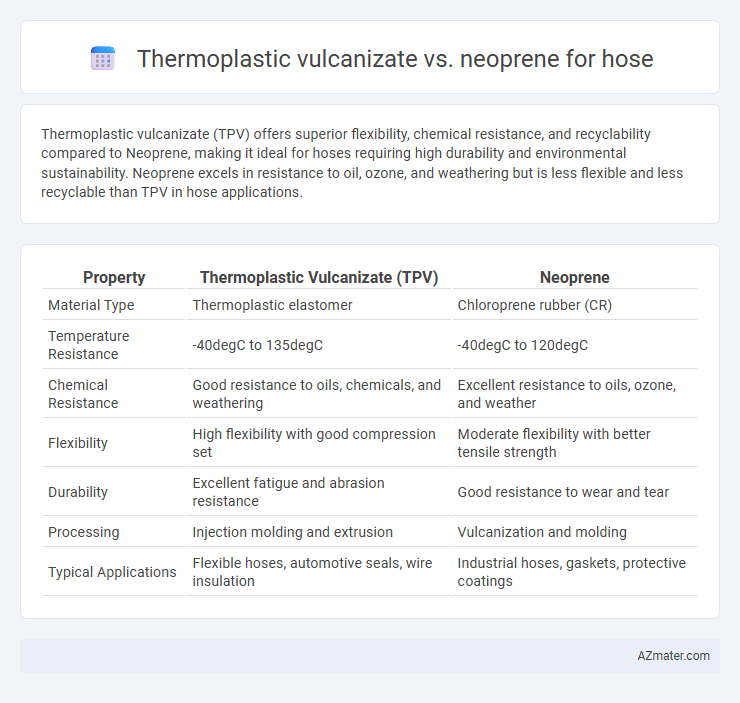Thermoplastic vulcanizate (TPV) offers superior flexibility, chemical resistance, and recyclability compared to Neoprene, making it ideal for hoses requiring high durability and environmental sustainability. Neoprene excels in resistance to oil, ozone, and weathering but is less flexible and less recyclable than TPV in hose applications.
Table of Comparison
| Property | Thermoplastic Vulcanizate (TPV) | Neoprene |
|---|---|---|
| Material Type | Thermoplastic elastomer | Chloroprene rubber (CR) |
| Temperature Resistance | -40degC to 135degC | -40degC to 120degC |
| Chemical Resistance | Good resistance to oils, chemicals, and weathering | Excellent resistance to oils, ozone, and weather |
| Flexibility | High flexibility with good compression set | Moderate flexibility with better tensile strength |
| Durability | Excellent fatigue and abrasion resistance | Good resistance to wear and tear |
| Processing | Injection molding and extrusion | Vulcanization and molding |
| Typical Applications | Flexible hoses, automotive seals, wire insulation | Industrial hoses, gaskets, protective coatings |
Introduction to Thermoplastic Vulcanizate and Neoprene
Thermoplastic vulcanizate (TPV) combines the elasticity of vulcanized rubber with the recyclability of thermoplastics, making it highly resistant to weathering, chemicals, and abrasion, ideal for durable hose applications. Neoprene, a synthetic rubber known for excellent chemical stability, oil resistance, and flexibility across temperature ranges, is widely used in hoses exposed to harsh environments and industrial fluids. Both materials offer unique benefits, with TPV providing recyclability and ease of processing, while neoprene excels in resilience and resistance to oils and solvents.
Chemical Composition and Structure
Thermoplastic vulcanizates (TPVs) consist of a dynamically vulcanized rubber phase dispersed within a thermoplastic matrix, typically polypropylene, providing flexibility and chemical resistance through a cross-linked elastomer network embedded in a thermoplastic base. Neoprene, a synthetic rubber made from polychloroprene, features a homogenous elastomeric structure with inherent resistance to oils, chemicals, and weather due to its chlorinated polymer backbone. The morphological contrast between TPV's phase-separated structure and Neoprene's uniform elastomer matrix results in differing mechanical and chemical resistance properties ideal for hose applications in various industrial environments.
Physical and Mechanical Properties Comparison
Thermoplastic vulcanizate (TPV) offers superior flexibility and excellent chemical resistance compared to neoprene, making it ideal for hoses exposed to dynamic movements and harsh environments. Neoprene exhibits greater abrasion resistance and enhanced durability under extreme temperatures, providing reliable performance in demanding industrial applications. Both materials have distinct mechanical strengths: TPV features higher elongation at break and resilience, while neoprene offers stronger tensile strength and resistance to ozone and weathering.
Flexibility and Elasticity Performance
Thermoplastic vulcanizate (TPV) exhibits superior flexibility and elasticity compared to neoprene, maintaining consistent performance across a wide temperature range from -60degC to 150degC. TPV's unique cross-linked rubber particles embedded in a thermoplastic matrix provide excellent elongation and resilient rebound, making it highly resistant to deformation under dynamic stress. Neoprene, while durable and resistant to oils and weathering, generally shows lower elasticity and can become stiff in colder environments, reducing hose flexibility during prolonged use.
Resistance to Chemicals and Oils
Thermoplastic vulcanizate (TPV) offers excellent resistance to a wide range of chemicals, including acids, alkalis, and many solvents, making it highly effective for hoses exposed to aggressive environments. Neoprene demonstrates strong oil and petroleum resistance, maintaining flexibility and durability in contact with fuels and lubricants. For applications requiring balanced chemical and oil resistance, TPV provides superior chemical stability, while neoprene excels where oil exposure is predominant.
Temperature Tolerance and Weatherability
Thermoplastic vulcanizates (TPVs) exhibit superior temperature tolerance, maintaining flexibility and elasticity in a range from -40degC to 140degC, making them ideal for dynamic hose applications exposed to fluctuating thermal conditions. Neoprene offers excellent weatherability, with strong resistance to ozone, UV rays, and oxidative degradation, ensuring hoses retain performance in outdoor and harsh environments. While TPVs excel in thermal stability and flexibility, neoprene's durability against environmental factors makes it preferable for hoses exposed to prolonged weather exposure.
Durability and Longevity in Hose Applications
Thermoplastic vulcanizates (TPVs) exhibit superior flexibility and resistance to deformation, ensuring extended durability in dynamic hose applications subjected to frequent bending and pressure fluctuations. Neoprene offers excellent resistance to oils, chemicals, and weathering, making it highly durable in harsh environmental conditions and industrial uses involving exposure to corrosive substances. When comparing longevity, TPVs generally provide enhanced fatigue resistance and thermal stability, while neoprene's strength lies in its chemical resistance and structural integrity over prolonged exposure to UV radiation and ozone.
Environmental Impact and Recyclability
Thermoplastic vulcanizates (TPVs) offer superior environmental benefits compared to neoprene, as TPVs are fully recyclable and can be reprocessed multiple times without significant degradation of properties. Neoprene, a chlorinated polymer, poses challenges in disposal due to its release of harmful chemicals when incinerated, contributing to environmental pollution and complicating recycling efforts. The eco-friendly nature of TPVs aligns with sustainability goals by reducing landfill waste and lowering the carbon footprint associated with hose manufacturing and disposal.
Cost Considerations and Availability
Thermoplastic vulcanizate (TPV) hoses generally offer lower production and material costs compared to neoprene, making them a cost-effective option for large-scale applications. Neoprene hoses often have higher prices due to their superior chemical resistance and durability, but they may require less frequent replacement, offsetting initial expenses. Availability-wise, TPV hoses are widely accessible in standard sizes and grades, whereas neoprene hoses might have more limited supply depending on specific industry requirements and geographic location.
Best Applications: Choosing the Right Material for Hose
Thermoplastic vulcanizate (TPV) offers excellent flexibility, chemical resistance, and temperature tolerance, making it ideal for automotive and industrial hoses exposed to oils and harsh environments. Neoprene excels in weather, ozone, and abrasion resistance, suited for outdoor applications and cold-weather hoses requiring durability and UV protection. Selecting the right material depends on operational temperature range, chemical exposure, and environmental factors to ensure optimal hose performance and longevity.

Infographic: Thermoplastic vulcanizate vs Neoprene for Hose
 azmater.com
azmater.com